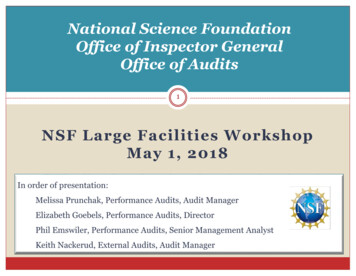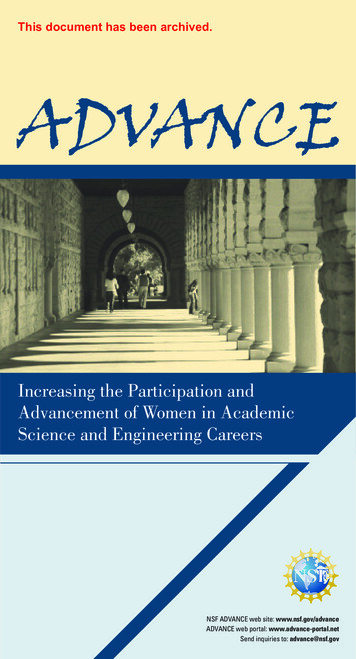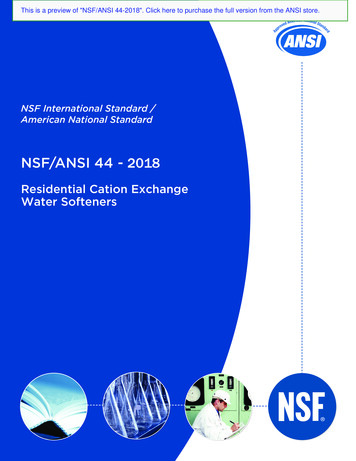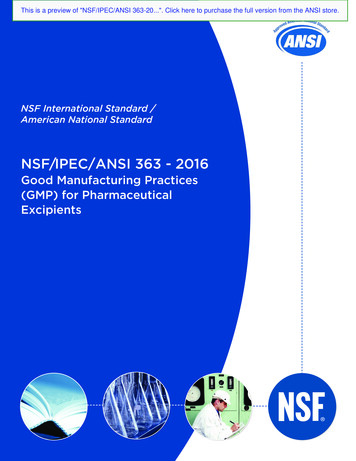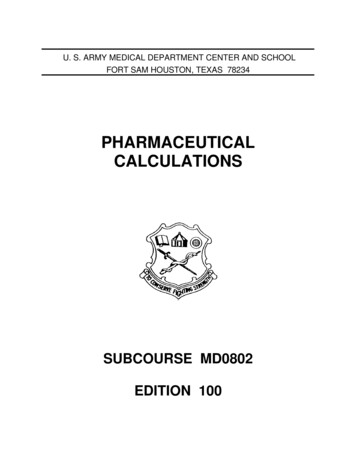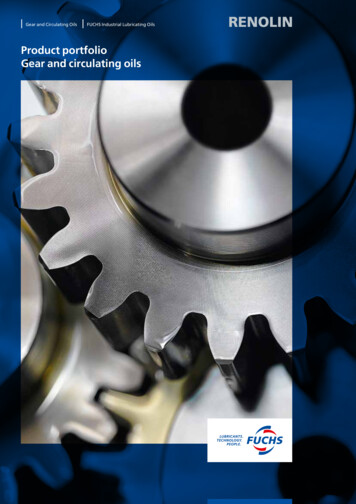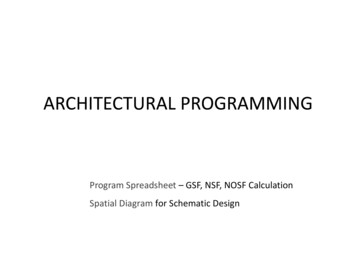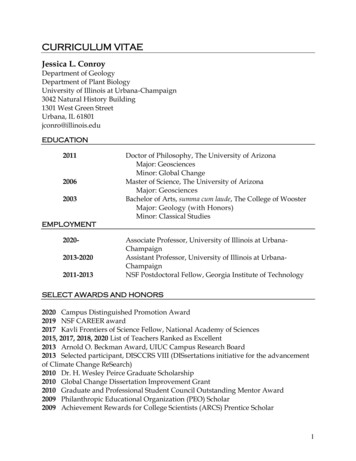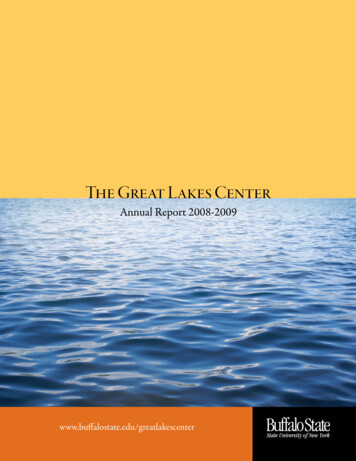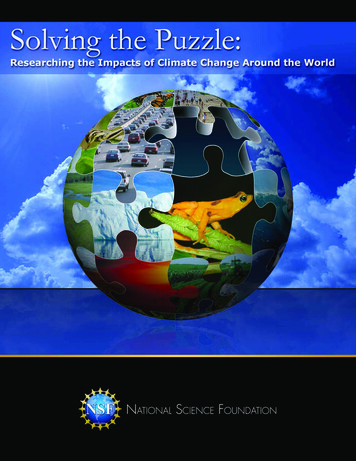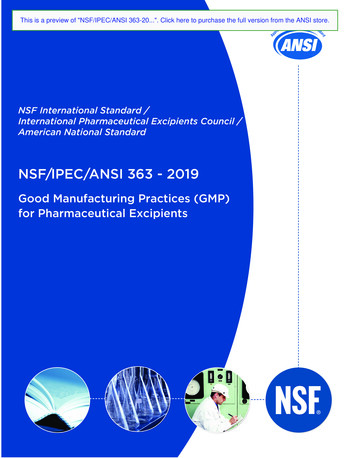
Transcription
This is a preview of "NSF/IPEC/ANSI 363-20.". Click here to purchase the full version from the ANSI store.NSF International Standard /International Pharmaceutical Excipients Council /American National StandardNSF/IPEC/ANSI 363 - 2019Good Manufacturing Practices (GMP)for Pharmaceutical Excipients
This is a preview of "NSF/IPEC/ANSI 363-20.". Click here to purchase the full version from the ANSI store.NSF International, an independent, not-for-profit,nongovernmental organization, is dedicated tobeing the leading global provider of public healthand safety-based risk management solutionswhile serving the interests of all stakeholders.This Standard is subject to revision.Contact NSF to confirm this revision is current.Users of this Standard may request clarifications andinterpretations, or propose revisions by contacting:Chair, Joint Committee on Pharmaceutical Excipientsc/o NSF International789 North Dixboro Road, PO Box 130140Ann Arbor, Michigan 48113-0140 USAPhone: (734) 769-8010 Fax: (734) 769-0109Email: info@nsf.orgWeb: www.nsf.org
This is a preview of "NSF/IPEC/ANSI 363-20.". Click here to purchase the full version from the ANSI store.NSF/IPEC/ANSI 363 – 2019NSF International Standard /International Pharmaceutical Excipients Council /American National Standardfor Pharmaceutical Excipients –Good Manufacturing Practices (GMP)for Pharmaceutical ExcipientsStandard DeveloperNSF InternationalDesignated as an ANSI StandardSeptember 20, 2019American National Standards Institutei
This is a preview of "NSF/IPEC/ANSI 363-20.". Click here to purchase the full version from the ANSI store.Prepared byThe NSF Joint Committee on Pharmaceutical ExcipientsRecommended for adoption byThe NSF Council of Public Health ConsultantsAdopted byNSF InternationalDecember 2014Revised January 2017Revised February 2020Published byNSF InternationalPO Box 130140, Ann Arbor, Michigan 48113-0140, USAFor ordering copies or for making inquiries with regard to this Standard, please reference the designation“NSF/IPEC/ANSI 363 – 2019”.Copyright 2020 NSF InternationalPrevious editions 2017, 2014Unless otherwise specified, no part of this publication may be reproduced or utilized in any form or by anymeans, electronic or mechanical, including photocopying and microfilm, without permission in writing fromNSF International.Printed in the United States of America.ii
This is a preview of "NSF/IPEC/ANSI 363-20.". Click here to purchase the full version from the ANSI store.Disclaimers 1NSF International (NSF), in performing its functions in accordance with its objectives, does not assume orundertake to discharge any responsibility of the manufacturer or any other party. The opinions and findingsof NSF represent its professional judgment. NSF shall not be responsible to anyone for the use of or relianceupon this Standard by anyone. NSF shall not incur any obligation or liability for damages, includingconsequential damages, arising out of or in connection with the use, interpretation of, or reliance upon thisStandard. It is the responsibility of the user of this standard to judge the suitability of the ANS for the user’spurpose.NSF Standards provide basic criteria to promote sanitation and protection of public health and theenvironment. Provisions for mechanical and electrical safety have not been included in this Standardbecause governmental agencies or other national standards-setting organizations provide safetyrequirements.Participation in NSF Standards development activities by regulatory agency representatives (federal, state,or local) shall not constitute their agency's endorsement of NSF or any of its Standards.Preference is given to the use of performance criteria measurable by examination or testing inNSF Standards development when such performance criteria may reasonably be used in lieu of design,materials, or construction criteria.The illustrations, if provided, are intended to assist in understanding their adjacent standard requirements.However, the illustrations may not include all requirements for a specific product or unit, nor do they showthe only method of fabricating such arrangements. Such partial drawings shall not be used to justifyimproper or incomplete design and construction.At the time of this publication, examples of programs and processes were provided for general guidance.This information is given for the convenience of users of this standard and does not constitute anendorsement by NSF International. Equivalent programs and processes may be used.Unless otherwise referenced, the annexes are not considered an integral part of NSF Standards. Theannexes are provided as general guidelines to the manufacturer, regulatory agency, user, or certifyingorganization.1The information contained in this Disclaimer is not part of this American National Standard (ANS) and has not beenprocessed in accordance with ANSI’s requirements for an ANS. Therefore, this Disclaimer may contain material thathas not been subjected to public review or a consensus process. In addition, it does not contain requirements necessaryfor conformance to the Standard.iii
This is a preview of "NSF/IPEC/ANSI 363-20.". Click here to purchase the full version from the ANSI store.This page is intentionally left blank.
This is a preview of "NSF/IPEC/ANSI 363-20.". Click here to purchase the full version from the ANSI store.Contents1 General . 11.1 Scope . 11.2 Purpose . 12Reference documents . 12.1 Normative references . 12.2 Informational references . 23Definitions . 34Context of the organization . 74.1 Understanding the organization and its context . 74.2 Understanding the needs and expectations of interested parties . 84.3 Determining the scope of the QMS. 84.4 QMS and its processes . 85Leadership . 95.1 Management commitment . 95.2 Quality policy. 95.3 Organizational roles, responsibilities and authorities . 106Planning . 106.1 Actions to address risks and opportunities . 106.2 Quality objectives and planning to achieve them . 116.3 Planning of changes . 117Support . 117.1 Resources . 117.2 Competence. 167.3 Awareness . 167.4 Communication . 167.5 Documented information . 178Operation . 198.1 Operational planning and control . 198.2 Requirements for products and services . 198.3 Design and development (out of scope) . 208.4 Control of externally provided processes, products, and services . 208.5 Production and service provision . 208.6 Monitoring and measurement of product . 238.7 Control of nonconforming materials . 249Performance evaluation . 269.1 Monitoring, measurement, and analysis . 269.2 Internal audit . 299.3 Management review. 2910 Improvement . 3010.1 General . 3010.2 Nonconformity and corrective action . 3010.3 Continual improvement . 30v
This is a preview of "NSF/IPEC/ANSI 363-20.". Click here to purchase the full version from the ANSI store.This page is intentionally left blank.
This is a preview of "NSF/IPEC/ANSI 363-20.". Click here to purchase the full version from the ANSI store.Foreword 2NSF/IPEC/ANSI 363 defines minimum cGMP standards for the manufacture and distribution ofpharmaceutical excipients. Certification to this Standard serves as a communication tool betweenmanufacturers of excipients and finished product manufacturers, pharmaceutical regulators, pharmacyorganizations, and consumers.NSF/IPEC/ANSI 363 was developed with participation from the pharmaceutical excipients manufacturers,public health regulators, and distributors of pharmaceutical excipients.This edition of the Standard contains the following revisions:Issue 11This revision adds more options for signatures on the Certificate of Analysis is Section 8.2.4.5.Issue 12This revision updates the language in Section 6.3.2.1.Issue 13This revision removes “waste segregation and disposal” from the form in Section 6.4.Issue 14This revision updates the entire standard to be better mapped to the new ISO 9001 format.This Standard was developed by the NSF Joint Committee on Pharmaceutical Excipients using theconsensus process described by the American National Standards Institute.This Standard and the accompanying text are intended for voluntary use by certifying organizations,regulatory agencies, and/or manufacturers as a basis of providing assurances that adequate healthprotection exists for covered products.Suggestions for improvement of this Standard are welcome. This Standard is maintained on a continuousmaintenance schedule and can be opened for comment at any time. Comments should be sent to:Chair, Joint Committee on Pharmaceutical Excipients at standards@nsf.org, or c/o NSF International,Standards Department, PO Box 130140, Ann Arbor, Michigan 48113-0140, USA.2The information contained in this Foreword is not part of this American National Standard (ANS) and has not beenprocessed in accordance with ANSI’s requirements for an ANS. Therefore, this Foreword may contain material that hasnot been subjected to public review or a consensus process. In addition, it does not contain requirements necessaryfor conformance to the Standard.vii
This is a preview of "NSF/IPEC/ANSI 363-20.". Click here to purchase the full version from the ANSI store.This page is intentionally left blank.
This is a preview of "NSF/IPEC/ANSI 363-20.". Click here to purchase the full version from the ANSI store. 2020 NSFNSF/IPEC/ANSI 363 – 2019NSF/IPEC/ANSI Standardfor Pharmaceutical Excipients –Good Manufacturing Practices (GMP)for Pharmaceutical Excipients1 General1.1ScopeThis Standard is intended to define good manufacturing practices (GMP) for excipient manufacture anddistribution 3 for use in drug products. It sets minimum requirements for GMP applicable to all commerciallyavailable excipients.NOTE 1 — The requirements of this Standard may not be sufficient for all applications of excipients. It is theuser's responsibility to determine whether or not this Standard meets the requirements for their intended use.NOTE 2 — Auditing excipient manufacturers ensures conformance to this Standard. This Standard is alsointended to be used by duly accredited or otherwise suitably qualified third-party audit and certificationproviders.NOTE 3 — Each user of a third-party auditing service should make its own determination as to thequalifications of the third party and the applicability of the report and/or certificate issued in satisfying itsrequirements, including those pertaining to its intended use of the excipient.1.2PurposeExcipients impact the appearance, stability, and delivery of drug products, and are essential to the safety,quality, and efficacy of these products. It is not possible to assure the consistent quality of excipients bytesting alone. Adherence to excipient GMP provides assurance that excipients are suitable for use in drugproducts. Excipient GMP require a proper quality management system (QMS), test methods, and facilitiesand controls.2 Reference documents2.1Normative referencesThe following documents contain requirements that, by reference in this text, constitute requirements of thisStandard. At the time of publication, the indicated editions were valid. All of the documents are subject torevision and parties shall investigate the possibility of applying the recent editions of the documentsindicated below. The most recent published edition of the document shall be used for undated references.WHO, Guidelines for Drinking-Water Quality, 4th edition, 2011 434GMP applies to distribution per the Federal Food, Drug, and Cosmetic Act (FD&C Act), 21 USC. 501(a) (2) (B).World Health Organization (WHO). 20 Avenue Appia, 1211 Geneva 27, Switzerland. www.who.int 1
NSF International, an independent, not- for-profit, nongovernmental organization, is dedicated to being the leading global provider of public health and safety-based risk management solutions while serving the interests of all stakeholders. This Standard is subject to revision. Contact NSF to confirm this revision is current.

